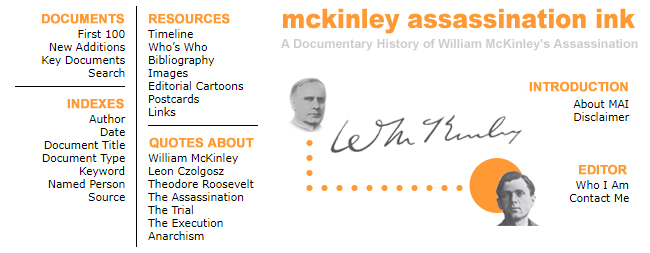|
Czolgosz Executed in Auburn Prison
The Assassin of President McKinley Pays the Penalty
in the Death Chair.
——
LAST ACT IN THE GREAT TRAGEDY.
——
Sullen and Unrepentant the Anarchist Murderer Goes to His Death,
Denouncing
Religion, Cursing the Priests and the Church and Declaring That
He Alone
Was Responsible for the Crime.
Auburn, N. Y. (Special).—Leon Czolgosz,
who shot and fatally wounded President McKinley in Buffalo on September
6, was electrocuted at 7.12.30 Tuesday morning in Auburn Prison.
He was shocked to death by 1700 volts of electricity. At 7.15 he
was pronounced dead. He went to the chair showing no particular
sign of fear and unaccompanied by a spiritual adviser. He surprised
everyone present by talking to the witnesses while being strapped
to the chair.
“I killed the President because he
was an enemy of the good people—of the good working people. I am
not sorry for my crime.”
A moment later he mumbled through
the half-adjusted face straps:
“I am awfully sorry I did not see
my father.”
In a few seconds the current of electricity
was turned on. The full voltage was used for seven seconds, and
was then slowly reduced for about forty-five seconds. The full voltage
of 1700 was then again turned on for eight seconds. A third time
the full strength of the current entered the body, although the
third contact was not thought necessary.
Czolgosz retired Monday night at 10
o’clock and slept so soundly that when Warden Mead went to the cell,
the guard inside had to shake Czolgosz to awaken him. The prison
official took from his pocket the death warrant and read it slowly
and distinctly to the assassin. Just as the warden stepped away
from the cell door Czolgosz called to him and said: “I would like
to talk with the Superintendent.”
The Warden responded: “He will be
down presently.”
Superintendent Collins visited the
cell at about 5.30 o’clock. The Superintendent stood in front of
the steel bars and Czolgosz said: “I want to make a statement before
you kill me. I want to make it when there are a lot of people present.
I want them to hear me,” said the prisoner.
“Well, you cannot,” said the Superintendent.
“Then I won’t talk at all,” said the
prisoner, sullenly.
After the Superintendent had left
the guards brought Czolgosz breakfast, consisting of coffee, toast,
eggs and bacon. Czolgosz seemed to relish the food. Meanwhile the
witnesses were gathering in the office of Warden Mead, and at 7.06
o’clock the procession passed to the death chamber. The witnesses
seated themselves and Warden Mead briefly addressed them, saying:
“You are here to witness the legal
death of Leon Czolgosz. I desire that you keep your seats and preserve
absolute silence in the death chamber, no matter what may transpire.”
Warden Mead gave the signal to have
the prisoner brought in, and at 7.10.30 o’clock Chief Keeper Tupper
swung open the big steel door leading to the cells of condemned
men.
When the attendants had strapped the
condemned man in the chair, they stepped back and Warden Mead raised
his hand. At 7.12.30 Electrician Davis turned the switch. At 7.15
the current was turned off. The prisoner was then dead, but two
minutes passed before the Warden turned to the witnesses and said:
“Gentlemen, the prisoner is dead.” The body was then placed on the
operating table. The clothing and personal effects of the prisoner
were burned under direction of Warden Mead a short time after the
execution.
The autopsy was completed shortly
before noon, when the surgeons issued the following brief statement:
“The autopsy was made by Mr. Edward
A. Spitzka, of New York, under the immediate supervision and direction
of Dr. Charles F. McDonald, of New York, and Dr. John Perin, prison
physician. The autopsy occupied over three hours, and embraced a
careful examination of all the bodily organs, including the brain.
The execution [sic] revealed a perfectly healthy state of
all the organs, including the brain.
“All of the physicians who attended
the execution were present at the autopsy, and all concurred in
the findings of the examiners.”
The body was placed in a black stained
pine coffin, every portion of the anatomy being replaced under the
supervision of Dr. Gerin and Warden Mead. Shortly afterward it was
taken to the prison cemetery, and an extraordinary precaution taken
to completely destroy it. A few days ago, under the Warden’s order,
an experiment was made to determine the power of quicklime in the
destruction of flesh and bone, which was not satisfactory. Warden
Mead at once conferred with some of the physicians present and determined,
in conjunction with Superintendent Collins, that the purpose of
the law was the destruction of the body, and that it was not necessary
to use quicklime for that end.
Accordingly, a carboy of acid was
obtained and poured upon the body in the coffin after it had been
lowered into the grave. Straw was used in the four corners of the
grave as the earth was put in to give vent to such gases as might
form.
It is the belief of the physicians
that the body will be entirely disintegrated within 12 hours. During
that time and as long as deemed necessary a guard will be kept over
the unmarked grave.
|


![]()